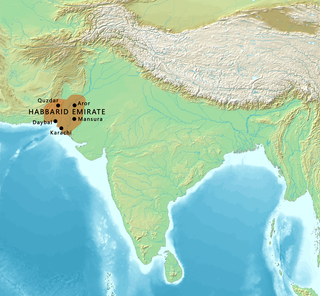
The Baloch or Baluch are a nomadic, pastoral, ethnic group which speaks the Western Iranic Balochi language and is native to the Balochistan region of South and Western Asia, encompassing the countries of Pakistan, Iran, and Afghanistan. There are also Baloch diaspora communities in neighbouring regions, including in Central Asia, and the Arabian Peninsula.

Banu Hashim is an Arab clan within the Quraysh tribe to which the Islamic prophet Muhammad Ibn Abdullah belonged, named after Muhammad's great-grandfather Hashim ibn Abd Manaf.

The history of Balochistan refers to the history of the Balochistan region of Pakistan, Iran and Afghanistan. Vague allusions to the region were found in Greek historical records of around 650 BCE. Prehistoric Balochistan dates to the Paleolithic.
Muslim Rajputs or Musalman Rajpoots are the descendants of Rajputs in the northern regions of the Indian subcontinent who generally are followers of Islam. They converted from Hinduism to Islam from the medieval period onwards, creating various dynasties and states while retaining Hindu surnames such as Chauhan. Today, Muslim Rajputs can be found mostly in present-day Northern India and Pakistan. They are further divided into different clans.
The Gabol is a Baloch tribe having a distinct identity through the centuries.
Sibi is a city situated in the Balochistan province of Pakistan. The city serves as the administrative headquarters of the district and tehsil of the same name.

The Khanate of Kalat, also known as the Baloch-Brahui Confederacy, was a Brahui Khanate that originated in the modern-day Kalat region of Pakistan. Formed in 1666 due to the threat of Mughal expansion in the region, it controlled the wider Balochistan at its greatest extent in the mid-18th century, extending from Kerman in the west to Sindh in the east and from Helmand River in the north to the Arabian Sea in the south.
Samma is a tribe that has origins in Sindh. The Samma are spread across Pakistan and North-West India. The Sandhai Muslims are Samma who converted to Islam. Offshoots of the main branch of Samma include the Jadejas and Chudasamas of India.

The Talpur Dynasty was a Baloch dynasty that ruled the Sind State after overthrowing the Kalhora dynasty in 1783 until British conquest of Sindh in 1843. A branch of the family continued to rule Khairpur, under British suzerainty and later as a Pakistani princely state, until 1955 when it was amalgamated into West Pakistan.
The Balochs of Sindh, is a community of Sindhi-speaking Baloch tribes living throughout the Sindh province of Pakistan.
Jat Muslim or Musalman Jat, also spelled Jatt or Jutt, are an elastic and diverse ethno-social subgroup of the Jat people, who are composed of followers of Islam and are native to the northern regions of the Indian subcontinent. They are found primarily throughout the Sindh and Punjab regions of Pakistan. Jats began converting to Islam from the early Medieval era onward and constitute a distinct subgroup within the diverse community of Jat people.

The Habbari were an Arab dynasty that ruled much of Greater Sindh, as a semi-independent emirate from 854 to 1024. Beginning with the rule of 'Umar bin Abdul Aziz al-Habbari in 854 CE, the region became semi-independent from the Abbasid Caliphate in 861, while continuing to nominally pledge allegiance to the Abbasid Caliph in Baghdad. The Habbari ascension marked the end of a period of direct rule of Sindh by the Umayyad and Abbasid Caliphates, which had begun in 711 CE.
Dodai is Baloch tribe. In Balochistan, Dodais are also included in Brahuis. Tribesmen of Dodai went on to found the towns of Dera Ismail Khan, Dera Ghazi Khan and Dera Fateh Khan. The Dodai rule lasted till the middle of the 18th century.
The Lodi dynasty was the last dynasty to rule over Emirate of Multan, from their capital city of Multan in the 10th century.

Mir Ahmad Yar Khan Ahmedzai (1902–1979), commonly referred to as Ahmad Yar Khan, was the last Khan of Kalat, a princely state in a subsidiary alliance with British India and the Dominion of Pakistan, serving from 10 September 1933 to 14 October 1955.
The Lashari is a Baloch tribe, mainly residing in Derajat, Makran, SindhSamad Lashari Digital market & cyber expert from Karachi pk orgin Gambat sindh, and the Kacchi Plain in east of Balochistan and Iran Sistan Balochistan Mainly in Lashar District Sistan.

The Langah Sultanate was a late medieval sultanate based in the Punjab region in the western Indian subcontinent between the 15th and 16th centuries. It was the dominant power of the lower Doab tract with Multan at its centre. The Langah Sultanate was annexed in 1527 but had autonomous authority until its merger with the Mughal Empire in 1530.

The Emirate of Multan was a medieval kingdom in Punjab region in the northwest Indian subcontinent that was centred around city of Multan. It initially extended towards parts of Kashmir, and included parts of present-day Punjab. It was initially ruled by the tribe of Banu Munabbih. In 959 CE, Ismailis under the Lodis gained control of the Emirate and in 1010, it was conquered by the Ghaznavid Empire.
The Sindhis of Balochistan are an indigenous Sindhi population living in Balochistan, Pakistan.
Gichki or Gitchki is a Rajput tribe living in the Makran region of Pakistan and Iran. The tribe, initially settled in the Gichk valley of Panjgur and now mostly Balochi-speaking, formed ruling class of the state of Makran from 1740 until 1955.









